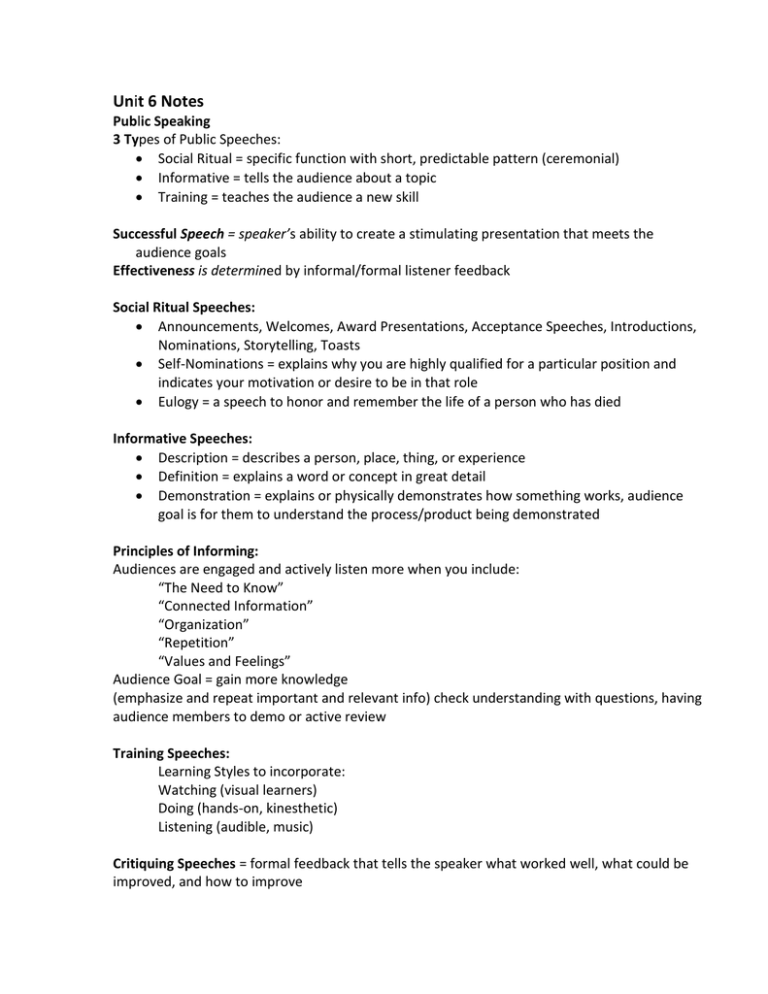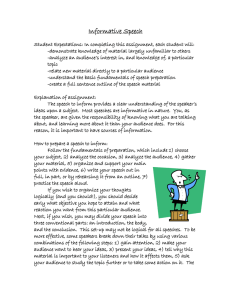Unit 6 Notes
advertisement

Unit 6 Notes Public Speaking 3 Types of Public Speeches: Social Ritual = specific function with short, predictable pattern (ceremonial) Informative = tells the audience about a topic Training = teaches the audience a new skill Successful Speech = speaker’s ability to create a stimulating presentation that meets the audience goals Effectiveness is determined by informal/formal listener feedback Social Ritual Speeches: Announcements, Welcomes, Award Presentations, Acceptance Speeches, Introductions, Nominations, Storytelling, Toasts Self-Nominations = explains why you are highly qualified for a particular position and indicates your motivation or desire to be in that role Eulogy = a speech to honor and remember the life of a person who has died Informative Speeches: Description = describes a person, place, thing, or experience Definition = explains a word or concept in great detail Demonstration = explains or physically demonstrates how something works, audience goal is for them to understand the process/product being demonstrated Principles of Informing: Audiences are engaged and actively listen more when you include: “The Need to Know” “Connected Information” “Organization” “Repetition” “Values and Feelings” Audience Goal = gain more knowledge (emphasize and repeat important and relevant info) check understanding with questions, having audience members to demo or active review Training Speeches: Learning Styles to incorporate: Watching (visual learners) Doing (hands-on, kinesthetic) Listening (audible, music) Critiquing Speeches = formal feedback that tells the speaker what worked well, what could be improved, and how to improve Guidelines: Be specific Establish some criteria (remember the speaker’s purpose) Describe what you saw and heard Limit your points Discuss strengths AND weaknesses “Improvement Sandwich” Recognize improvement Persuasion = communication process with the goal of influencing others Persuasive Process 1. Decide on a audience goal 2. Analyze your listeners 4 types of listeners: Supportive, Uncommitted, Indifferent, and Opposed 3. Create logical, emotional, and credibility appeals 4. Organize & deliver the message 5. Evaluate your effectiveness Maslow’s Hierarchy of Needs Appeals: Aristotle’s logos (logical), pathos (emotional), and ethos (credibility) Logical Inductive Deductive Cause Effect Emotional Maslow’s Hierarchy Guilt, fear, freedom, justice, greed, patriotism, belonging, anger, happiness Credibility Believability Ethical standards Knowledge Faulty Appeals = incorrect or misleading strategies based on inaccurate or illogical arguments Examples: defective evidence, slippery slope fallacies, glittering generalities, red herrings, band wagon appeals Organization 3 styles: Statement of reasons Problem – Solutions Monroe’s Motivational Sequence 1. Get the audience’s attention 2. Explain your proposal 3. Suggest what they need to do to take 4. Paint the picture of the benefits 5. Tell the Audience what actions they need




